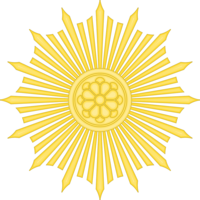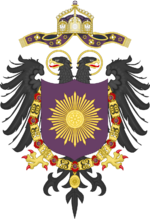Achysian Monarchy
This article is incomplete because it is pending further input from participants, or it is a work-in-progress by one author. Please comment on this article's talk page to share your input, comments and questions. Note: To contribute to this article, you may need to seek help from the author(s) of this page. |
Exalted Achysian Monarchy | |||||||||
|---|---|---|---|---|---|---|---|---|---|
| 1466–1809 | |||||||||
Motto: Fiat justitia, ruat caelum! 'Let justice be done, through the heaven's fall!' | |||||||||
Anthem: March of the Emperors | |||||||||
| The Achysian Monarchy at its height The Achysian Monarchy at its height | |||||||||
| Capital | Veranium | ||||||||
| Common languages | Achysian, Elyrian | ||||||||
| Religion | Vayonism | ||||||||
| Government | Absolute Universal Monarchy | ||||||||
| Emperor | |||||||||
• 1466-1500 | Theodosius the Divine | ||||||||
• 1616-1650 | Charles the Great | ||||||||
• 1740-1786 | Michael the Brave | ||||||||
• 1786-1809 | Aelius the Last | ||||||||
| Grand Logothete | |||||||||
| Legislature | Senate | ||||||||
| Imperial Council | |||||||||
| Imperial Curia | |||||||||
| Historical era | Various | ||||||||
| May the 16th 1453 | |||||||||
• Established | May the 16th 1466 | ||||||||
| May 13th 1809 | |||||||||
• Disestablished | May the 13th 1809 | ||||||||
| 16 May 1809 | |||||||||
| Currency | Auriol | ||||||||
| |||||||||
| Today part of | Baccania Ichoria Kathmandue Mammo Mapleston Penania Raventsvo Achysia Thynia Topsail Totenheim Zephyrio | ||||||||
| |||||||||
Part of a series on the |
|---|
| History of Achysia |
 |
| Timeline |
The Achysian Monarchy, officially known as the Exalted Achysian Monarchy, was a union of multiple realms brought together by the Radiant Crown, the Achysian imperial line of monarchs, and was one of the largest empires in history. Being centered around the leading Achysian imperial title, this composite monarchy was most often equated with Achysia itself, even as the Radiant Crown controlled important territories throughout Aurora and a significant overseas empire, being one of the first realms to become known as the empire on which the sun never sets.
Achysia was the cultural, political, and military center of this empire throughout most of its history, but the empire was not exclusively Achysian. Imperial authority was moved away from Achysia multiple times in its history, with the best known period being that of the personal union with Ichoria, and while the territories of the Achysian realm were ruled under a despotic administrative monarchy, the feudal relations in this union of crowns led to many of the member realms maintaining their own administrations, despite the historical attempts of several monarchs to centralize or reorganize the empire. As such, the monarch's power varied from realm to realm, and power was delegated away from Achysia to a system of councils.
After its development from the last remains of the Veranian Empire, the Achysian state experienced a series of military expansions and a marked decline of its previous medieval, Elyrian identity. The Achysian protection of the Haliarch granted its monarchs a significant power in the religious life of Aurora, and this support from the Faith was crucial in the initial Achysian colonial expansion, which was done in the name of expanding Vayonism and converting the natives. The colonial empire in turn granted the Achysian monarchs the power they needed for their continental policies. The cultural rebirth of the idea of Elyrian unionism, and Achysian support for the Haliarchal dogmatism played important roles in the beginning of the Wars of the Faith, a series of interconnected conflicts which scarred Aurora and its colonies for nearly a century.
The Wars allowed the Achysian Monarchy to gain a dominant position on the continent, which was disputed by its main rival in Kathia. Despite setbacks during the Wars, the personal union with Ichoria allowed Daeron the Great to retain his empire's dominance through a series of brutal military campaigns. Even through the imperial center of power initially moved to Azhara, the forced inclusion of the Kathic throne in this union of realms directly led to Daeron's attempts to restore the Elyrian Empire of old - the concept of a universal monarchy, one realm, one emperor, one faith. These wars however severely weakened the empire, and the centralizing reforms were incredibly unpopular outside of Achysia. Daeron's son and successor, Kaeron the Martyr, oversaw the rebellions of Ichoria and Kathia and a military disaster, which after his death permanently ended Achysia's dreams of continental hegemony.
Despite a period of decline, and an initial fall towards the status of a secondary power for Achysia, the following monarchs focused on reforming their economy and colonial empire, which led to a certain recovery in the 18th century. Continued imperial failures in Auroran affairs however led to an increased diplomatic isolation and internal decadence. This made Achysia unable to resist a Kathic invasion in 1809 during the Republican Wars, with the monarchy collapsing and the country being embroiled in another continental conflict and then in a civil war which would only end in 1822 with an absolutist victory and the restoration of the monarchy that would however mark the beginning of another historical era.


